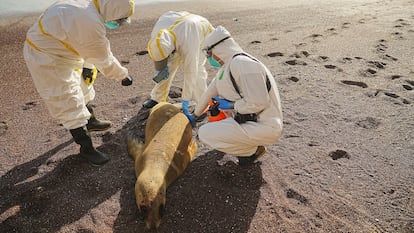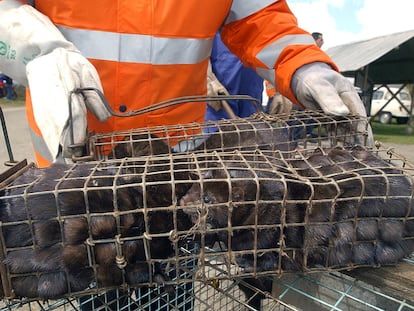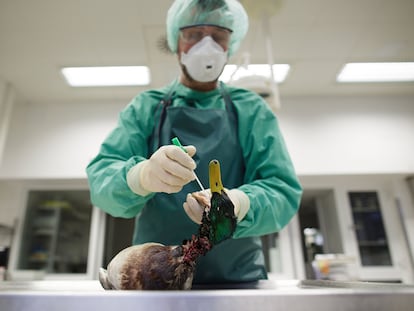Mass death of sea lions from bird flu suggests virus may be spreading between mammals in the wild
A study of the fatal outbreak in Peru indicates that the highly pathogenic avian influenza may have mutated in a way unseen so far in nature
Hundreds of dead or dying sea lions have washed up on the beaches of Peru since January. Before dying, the animals – majestic carnivores that can weigh up to 350 kilos – had been suffering from agonizing convulsions and struggling to swim. Nothing like this had ever been observed in the region. A scientific team of Peruvian and Argentine researchers has now confirmed that the mass mortality of the sea lions is due to the A(H5N1) bird flu virus, which has jumped from seabirds to these wild mammals. Researchers are not ruling out a terrifying hypothesis: that the virus may have learned to spread from mammal to mammal, as it apparently did on a Spanish mink farm. It would be the first time that this has occurred in nature.
A total of 634 sea lions have been found dead in Peru. The leading theory is that the mammals were infected one by one, independently, by living with sick birds or eating their corpses, according to Argentine biologist Sergio Lambertucci, one of the leaders of the investigation. The scientist, however, points to a concerning episode on January 27, when a hundred dead sea lions were found floating in the waters of Isla Asia, less than 60 miles (100 kilometers) south of Lima, the capital of Peru. “It wouldn’t be strange if a few of them had eaten infected birds, but all of them?” says Lambertucci, who is a researcher at the Biodiversity and Environment Research Institute in the Argentine city of San Carlos de Bariloche.
Dutch veterinarian Thijs Kuiken, an expert on emerging diseases, is also skeptical of the hypothesis that each sea lion was infected independently. “Given the large number of specimens found dead, it seems more likely that there was direct transmission between sea lions,” says Kuiken, from the Erasmus University Medical Center in Rotterdam. “It’s worrying,” he continues. “This is the second mass mortality episode to suggest that this virus can readily adapt to efficient mammal-to-mammal transmission. If it can occur in mink and sea lions, why wouldn’t it happen in humans?”
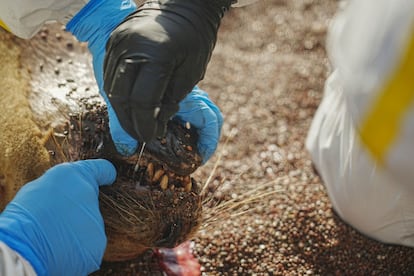
The A(H5N1) virus circulating around the world is a subtype of the highly pathogenic avian influenza. In Europe, it has caused the most devastating epidemic in history, with more than 50 million poultry slaughtered in just one year. The virus reached South America in late 2022, wreaking havoc in Peru, where it has killed more than 50,000 wild birds, mostly pelicans and boobies, according to data from Peruvian and Argentine scientists. The pathogen has jumped many times from bird to mammal, even to people in exceptional cases. In these case, however, there has not been mammal-to-mammal transmission. Scientists fear that the virus could mutate and cause a deadly pandemic among humans.
Thijs Kuiken lists another reason for concern: “There is video footage showing people in Peru trying to rescue sea lions potentially infected with the virus. This close contact increases the chances of the virus being transmitted from sea lions to humans.” The Peruvian government has asked citizens not to approach the wild animals. On January 3, a nine-year-old girl from Ecuador – who was in contact with backyard poultry – was admitted to the intensive care unit in critical condition after being infected with the A(H5) virus. According to the World Health Organization, the girl recovered from the virus. It was the first reported case of human infection by this strain of the avian influenza in Latin America.
In Peru, the 634 dead sea lions have been found on various beaches and protected areas in the country, such as the Paracas National Reserve. Researchers analyzed six specimens and found the virus in all of them. Autopsies of other specimens also detected traces of bird flu, i.e. hemorrhagic pneumonia in the lungs and hemorrhagic encephalitis in the brain. Lambertucci points out that sea lions are very social animals, living in colonies that are often overcrowded. “If you have to think of wild species with the highest probability of mammal-to-mammal transmission, you would look to social animals such as sea lions, which live very close to each other,” says Lambertucci.
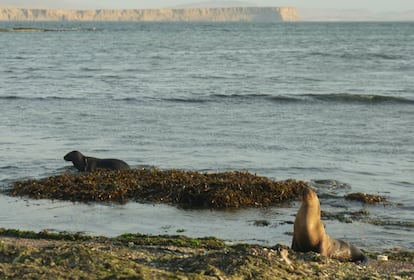
Before publishing their findings on the sea lions, the team of Peruvian and Argentine scientists had warned that the arrival of the bird flu virus posed a threat to protected birds in South America, including the Andean condor. Faced with the mass mortality of the sea lions, the researchers decided to urgently publish the first draft of their study on the mammals, without waiting to complete it. “We wanted to raise the alert as soon as possible due to the worrying nature of the situation. It is the first case of mass mortality of wild mammals in South America and could be the first event of intraspecies transmission in wild mammals in the world,” explains Lambertucci. The Argentine biologist stresses that they will need to carry out genetic studies of the virus to confirm or rule out their hypotheses – work that will take weeks.
Peruvian ornithologist Víctor Gamarra, co-author of the study, laments the slow reaction of the authorities. “We published the letter in Science precisely to draw the attention of Latin American governments to the need to do monitoring, an epidemiological analysis and to see what other species were affected,” explains Gamarra, from the National University of San Agustin de Arequipa. “There was an epidemiological silence, in which the public institutions stated that everything was under control. And suddenly these reports appeared of people finding dead sea lions all over the Peruvian coast. That is when the institutions began to take some samples,” says Gamarra. Among the Peruvian co-authors of the study, seven are members of the National Service of Natural State-Protected Areas.
In Spain last year, there were 37 outbreaks of the highly pathogenic avian influenza in poultry and another 138 cases in wild birds. In one of the outbreaks, on a farm with 150,000 laying hens in the city of Guadalajara, two workers became infected without developing symptoms. In October, the virus entered a fur farm with 52,000 American mink in Carral, a few minutes’ drive from the city of A Coruña. Mortality in this outbreak exceeded 4% in a single week. A study led by Montserrat Agüero, from the Spanish Ministry of Agriculture’s Central Veterinary Laboratory, suggested that the avian virus mutated at the mink farm and was then transmitted from mammal to mammal. The Spanish outbreak set off alarm bells around the world. Even the British doctor Jeremy Farrar, newly appointed scientific director of the World Health Organization, warned on social media of the risk of “a devastating flu pandemic.”
Sign up for our weekly newsletter to get more English-language news coverage from EL PAÍS USA Edition
Tu suscripción se está usando en otro dispositivo
¿Quieres añadir otro usuario a tu suscripción?
Si continúas leyendo en este dispositivo, no se podrá leer en el otro.
FlechaTu suscripción se está usando en otro dispositivo y solo puedes acceder a EL PAÍS desde un dispositivo a la vez.
Si quieres compartir tu cuenta, cambia tu suscripción a la modalidad Premium, así podrás añadir otro usuario. Cada uno accederá con su propia cuenta de email, lo que os permitirá personalizar vuestra experiencia en EL PAÍS.
¿Tienes una suscripción de empresa? Accede aquí para contratar más cuentas.
En el caso de no saber quién está usando tu cuenta, te recomendamos cambiar tu contraseña aquí.
Si decides continuar compartiendo tu cuenta, este mensaje se mostrará en tu dispositivo y en el de la otra persona que está usando tu cuenta de forma indefinida, afectando a tu experiencia de lectura. Puedes consultar aquí los términos y condiciones de la suscripción digital.
More information
Archived In
Últimas noticias
Maduro pleads not guilty before the federal court in New York: ‘I am still the president of Venezuela’
A new test can detect Alzheimer’s from a finger prick
UN team enters Sudanese city of El Fasher after paramilitary massacre: ‘It’s like a ghost town’
A recipe for resistance: Indigenous peoples politicize their struggles from the kitchen
Most viewed
- Gilles Lipovetsky: ‘If you want to live better and fall in love, take Prozac, don’t look to philosophy’
- Alain Aspect, Nobel laureate in physics: ‘Einstein was so smart that he would have had to recognize quantum entanglement’
- Alvin Hellerstein, a 92-year-old judge appointed by Bill Clinton, to preside over Maduro’s trial in New York
- Why oil has been at the center of Venezuela-US conflicts for decades
- Maduro’s downfall puts China’s relationship with Venezuela to the test
